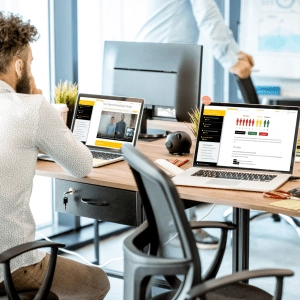Al Jazeera Head of Creative Solutions contacted Datalabs in 2015 to see if we could organise a workshop to train Al Jazeera’s designers on infographics. They wanted to learn more about using data, how to find the right data and how to present it in broadcast formats.
It took until 2017 to get the logistics sorted (who’d have thought a dual language, 24-hour international news channel would be busy, huh?). In May we took a brief on a custom, two-day workshop. The brief was to take the content creators, presenters (journalists) and the design teams into a workshop where they’d design infographics together.
The problems were easily defined: Al Jazeera identified infographics as a tool to complement the story a while back and was looking for experts to help implement.
Day One – Session 1 – Journalists/Producers & Designers
The first session introduced the teams we’d be working with over the next two days. We took the group through our background in data visualisations, infographics and motion graphics. We established the needs of their teams and individuals, and, the problems they were facing in a data/design to production sense.
We quickly found out that the teams were (naturally) incredibly skilled in their fields and had been mainly struggling with communicating data from a researcher to their story producers and then to briefing their designer to production within short time frames – usually, just one or two 8-hour shifts.
After this process, they needed to produce world-class broadcast quality design, often in interactive (touch screen TV wall) or immersive 3d format that the presenter could walk through and interact with. And all in time to make the news!
Day One – Session 2 – Journalists & Producers
In the first session with the producers & journalist team, we took the group through the basics of researching, structuring and briefing an infographic. The practical exercise showed how to deconstruct an infographic into a written form. This gives a perspective on how to brief for infographics. It gives a good overview of the production cycle of an infographic design (or any visual content – microsite, animation, interactive data visualisation).
As we were taking the team through the infographic work we do as an agency, it became clear that they needed help with the communication of data and how to brief designers when using data.
In the second session, we took them through our own briefing/process documents. We worked on how they should choose data, how much to use and how to structure it visually. We also talked about when to use data, as opposed to icons, written content or images/video to best convey the message and support the infographic.
Main topics covered:
Using & Choosing Data, Briefing Designers, Structure of Infographics, Complex Data & Visualisations, Finding a Narrative.
Day One – Session 3 -Designers
We took the ‘second stream’ of designers through the process that we use to take a brief, sketch ideas, structure and choose the right format for the story and audience.
We showed them how we setup projects, run design feedback sessions and how we deal with large and small data sets. We showed them how we use our process documentation and respond to feedback.
The biggest learning from this session is getting a better understanding of the ‘client’ is important. This is often a conclusion when we have designers in workshops. It can be an internal client (i.e another team or department) or external (another business). When we get a common understanding of the project, both groups use a common ‘data vocabulary’ and get systems in place to brief and provide feedback that gets great results.
Day Two – Session 4 – Journalists & Producers
In the first session of the second day, we took the production and journalist team through our take on data journalism and how to sketch out a story, visually. We took them through our process, data gathering, cleansing and a quick introduction. In the second part of the session, we took them through Tableau and how we use it to form the basis of stories, cleanse data and how we use it to look for stories.
The main outcome of this session was to help define a process for deciding when an infographic would be best used for broadcast.
Day Two – Session 5 – Designers
In the design session, we took the designers through the storyboarding process. We workshopped a specific brief and storyboard document that could be used for animated data or motion graphics. The outcome of this session was an in-depth briefing document to allow the designers to get more detail straight from the beginning in a clear and streamlined format.
Day Two – Session 6 – Journalists/Producers & Designers
The final session brought together the groups and had them working in a design and producer team of two. The groups were given 2 written stories (see example) with some data points and were tasked with creating a 6 module storyboard for an infographic.
The teams presented the storyboard, structure and wireframes to the group as part of the final exercise.
Workshop Outcomes
We established a process for briefing infographics. We had the teams work together and gain a greater understanding of their methods and processes. This lead to a greater affinity with each other’s needs, motivations and problems. A definition of what an infographic is within Al Jazeera was also created and together we established how much data needs to be included before it can be termed an infographic and put into productions.






